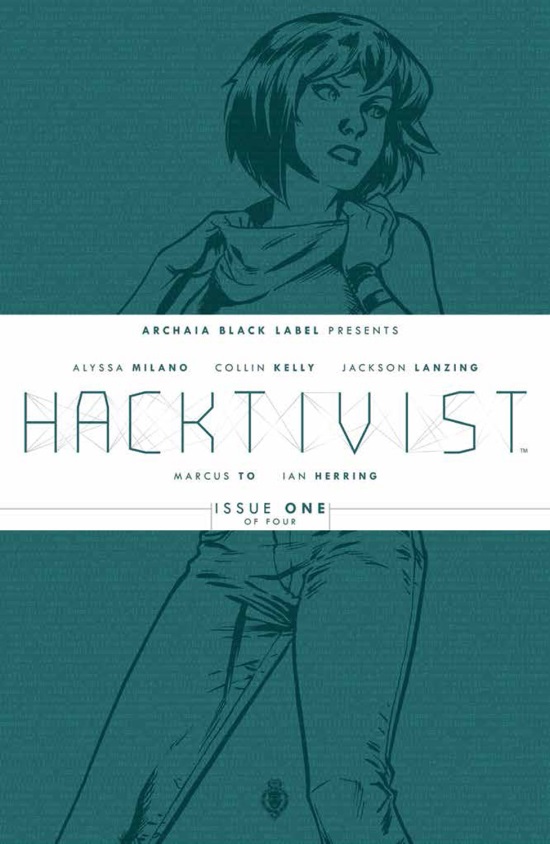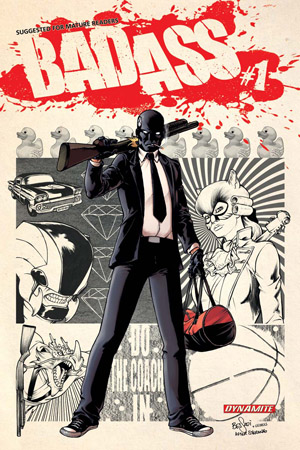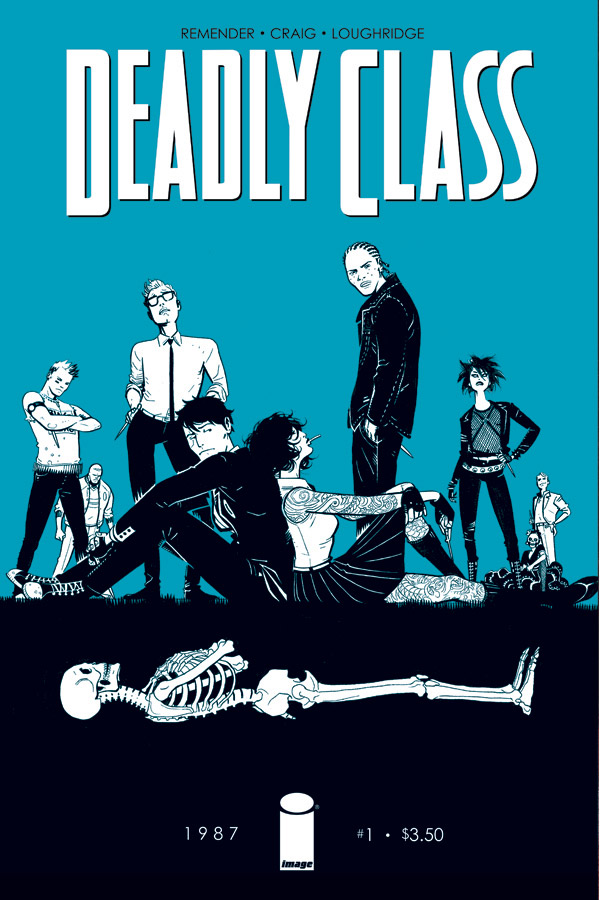We’re No. 1! is a weekly feature looking at first issues in new comic series, as well as one-offs and special releases. In his reviews, Jeff highlights stories with diverse characters and plot lines Geekquality readers can care about, as well as points out comics that miss the mark.
 Our first book this week is the highly offensive Bo: Plushy Gangsta #1 from Action Lab. Bo is a hard core gang banger, with all the horrible trappings and stereotypes that come with it. He’s foul mouthed and incredibly violent, constantly refers to women as “bitches” and “hoes” and treats them like property, and conforms to just about every negative stereotype of street gang culture. And, for whatever reason, he’s a teddy bear. At some point he was apparently cursed by a voodoo priestess and the soul of Bo the gangster was trapped in a cuddly bear, which from time to time unleashes the spirit of an actual huge monstrous bear. The art suffers as much as the writing, with caricatures so blatant its hard to believe anyone would agree to publish them. Writer Pavel Balabanov and artist Vasily Terentiev completely missed the opportunity to use a child’s toy as a symbol of innocence that could shine a light on all the negative aspects of street life for so many young men. Instead, Bo is simply a cruel person and ultimately a horribly failed, childish joke, set in a misogynistic and racist story.
Our first book this week is the highly offensive Bo: Plushy Gangsta #1 from Action Lab. Bo is a hard core gang banger, with all the horrible trappings and stereotypes that come with it. He’s foul mouthed and incredibly violent, constantly refers to women as “bitches” and “hoes” and treats them like property, and conforms to just about every negative stereotype of street gang culture. And, for whatever reason, he’s a teddy bear. At some point he was apparently cursed by a voodoo priestess and the soul of Bo the gangster was trapped in a cuddly bear, which from time to time unleashes the spirit of an actual huge monstrous bear. The art suffers as much as the writing, with caricatures so blatant its hard to believe anyone would agree to publish them. Writer Pavel Balabanov and artist Vasily Terentiev completely missed the opportunity to use a child’s toy as a symbol of innocence that could shine a light on all the negative aspects of street life for so many young men. Instead, Bo is simply a cruel person and ultimately a horribly failed, childish joke, set in a misogynistic and racist story.
 While the rest of this week’s fare is not nearly so offensive, there aren’t a great many jewels to consider. A second smaller label, Archaia Black Label (recently acquired by Boom! Studios) teams up with Hollywood star Alyssa Milano to present Hacktivist #1. (The book is apparently conceived by Milano but writing credits go to Callin Kelley and Jackson Lanzing, with art by Marcus To). It’s the story of Ed Hiccox and Nate Graft, two Internet billionaires who own Yourlife, a social network based entirely around concepts of user privacy. They are also the secret hacker collective known as sve_Urs3lf, responsible for helping revolutionaries around the globe. After helping protestors spark the Tunisian uprising, these Internet billionaires move from an Apple-like mass media presentation to a lavish Facebook style party in New York City, where they are approached by the CIA and asked to assist in government cyber warfare using their talents and their company. The crux of the plot ahead seems to be how the two men – as different as night and day in both personal habits and philosophy – will deal with the discovery of their secret online identities, but it’s difficult to care much about what happens to them. While the book speaks to many topics of the moment, from privacy to financial inequality and even personal and religious freedom, it does so from an appalling place of privilege. The two men supposedly fighting for these ideals are incredibly wealthy white men, exactly the Silicon Valley stereotypes that they sound like. The idea that they basically started the Arab Spring is ridiculous in concept and frankly, offensive to the many people who risked their own life and liberty to illicit change in their homeland. Ultimately, while the book wants to have its heart in the right place, it comes across as a not very interesting adventure story zeroing in on readers’ interest in social change and equality, without adding anything particularly positive.
While the rest of this week’s fare is not nearly so offensive, there aren’t a great many jewels to consider. A second smaller label, Archaia Black Label (recently acquired by Boom! Studios) teams up with Hollywood star Alyssa Milano to present Hacktivist #1. (The book is apparently conceived by Milano but writing credits go to Callin Kelley and Jackson Lanzing, with art by Marcus To). It’s the story of Ed Hiccox and Nate Graft, two Internet billionaires who own Yourlife, a social network based entirely around concepts of user privacy. They are also the secret hacker collective known as sve_Urs3lf, responsible for helping revolutionaries around the globe. After helping protestors spark the Tunisian uprising, these Internet billionaires move from an Apple-like mass media presentation to a lavish Facebook style party in New York City, where they are approached by the CIA and asked to assist in government cyber warfare using their talents and their company. The crux of the plot ahead seems to be how the two men – as different as night and day in both personal habits and philosophy – will deal with the discovery of their secret online identities, but it’s difficult to care much about what happens to them. While the book speaks to many topics of the moment, from privacy to financial inequality and even personal and religious freedom, it does so from an appalling place of privilege. The two men supposedly fighting for these ideals are incredibly wealthy white men, exactly the Silicon Valley stereotypes that they sound like. The idea that they basically started the Arab Spring is ridiculous in concept and frankly, offensive to the many people who risked their own life and liberty to illicit change in their homeland. Ultimately, while the book wants to have its heart in the right place, it comes across as a not very interesting adventure story zeroing in on readers’ interest in social change and equality, without adding anything particularly positive.
 Next up is Bad Ass #1 from Dynamite Comics, written by Herik Hanna with art by Bruno Bessadi. The main character is Dead End, a smart mouth assassin in a black mask and suit, ready to wreak havoc on gangsters and civilians alike. He makes snarly remarks about babies, by the dozen kills goons serving the lizard-like crime lord The Green Dragon, and engages in hand to hand combat and verbal word play with Amadeus Kitty, an assassin who seems to be a cross between Catwoman and Mozart. This book, thankfully, doesn’t take itself too seriously, though that doesn’t excuse it from using a transphobic slur. Ultimately, Dead End comes off as a loutish and considerably less funny rip-off of Marvel’s Deadpool. The offensive language goes beyond painting the character as a jerk, showing a lack of empathy from the creators.
Next up is Bad Ass #1 from Dynamite Comics, written by Herik Hanna with art by Bruno Bessadi. The main character is Dead End, a smart mouth assassin in a black mask and suit, ready to wreak havoc on gangsters and civilians alike. He makes snarly remarks about babies, by the dozen kills goons serving the lizard-like crime lord The Green Dragon, and engages in hand to hand combat and verbal word play with Amadeus Kitty, an assassin who seems to be a cross between Catwoman and Mozart. This book, thankfully, doesn’t take itself too seriously, though that doesn’t excuse it from using a transphobic slur. Ultimately, Dead End comes off as a loutish and considerably less funny rip-off of Marvel’s Deadpool. The offensive language goes beyond painting the character as a jerk, showing a lack of empathy from the creators.
 Things begin to look up in Empire of the Dead #1 from legendary zombie scribe George Romero. Set five years after a zombie apocalypse, New York has become a city-state where the undead are pitted against each other in the arena like Roman gladiators. Paul Barnum hunts through impoverished and abandoned neighborhoods, collecting walking corpses for the arena. He sells the more aggressive zombies he catches to the Mayor, who runs the show in more ways than one. Academic Penny Jones is a doctor who believes that zombies carry more of their humanity after infection than most are willing to believe or admit. If she’s right, the Mayor’s horror show becomes so much worse. One of the most interesting characters in the story is lost SWAT officer Frances Xavier, a police officer who was bitten and left behind in the subways of the Big Apple. She has more going on upstairs than most might expect from a zombie, and the parts of the story told from her point of view are riveting, and original in the genre. While the plot is interesting and holds great twists, it’s Jones and Xavier who make the book all the more compelling, and if you like corpses-with-a-hunger-for-brains fiction, this is a good one from the man who started it all.
Things begin to look up in Empire of the Dead #1 from legendary zombie scribe George Romero. Set five years after a zombie apocalypse, New York has become a city-state where the undead are pitted against each other in the arena like Roman gladiators. Paul Barnum hunts through impoverished and abandoned neighborhoods, collecting walking corpses for the arena. He sells the more aggressive zombies he catches to the Mayor, who runs the show in more ways than one. Academic Penny Jones is a doctor who believes that zombies carry more of their humanity after infection than most are willing to believe or admit. If she’s right, the Mayor’s horror show becomes so much worse. One of the most interesting characters in the story is lost SWAT officer Frances Xavier, a police officer who was bitten and left behind in the subways of the Big Apple. She has more going on upstairs than most might expect from a zombie, and the parts of the story told from her point of view are riveting, and original in the genre. While the plot is interesting and holds great twists, it’s Jones and Xavier who make the book all the more compelling, and if you like corpses-with-a-hunger-for-brains fiction, this is a good one from the man who started it all.
 We save the best for last this week, with superstar creator Rick Remender’s Deadly Class #1 from Image. It’s 1987 and Marcus Lopez has been living on the streets of San Francisco since the death of his parents and a subsequent mysterious “incident” at his orphanage. Marcus finds himself attacked by a group of armed men and then rescued by a young Japanese woman and a handful of teenagers. After saving his life, they recruit Marcus to attend a very special underground school, King’s Dominion High School for the Deadly Arts. It seems they know all about his murderous streak that led him to his current lot in life and they’re ready to train him to be one of the world’s top assassins. This trope, a secret school teaching talented kids a mysterious skill set, is certainly one we’ve seen before. The best part of Deadly Class, however, is its nostalgic and heartfelt look at the teen underground of the late 1980’s. The skaters, rockabilly kids, punks, goths and hip-hop kids are all lavishly represented here, both in Remender’s writing and in the fantastic art by Wes Craig, with stunning colors by legendary colorist Lee Loughridge. One can practically hear Black Flag and The Smiths alternating through the violent chase scenes and the vivid depictions of San Francisco, and the book does a great job of setting the mood in just one issue. The story promises to address some interesting view points on the teenage high school dynamic, which we haven’t gotten to just yet, what with all the narrative set-up. Yet, the intro here puts the meal well on the plate, and I for one will be back for more.
We save the best for last this week, with superstar creator Rick Remender’s Deadly Class #1 from Image. It’s 1987 and Marcus Lopez has been living on the streets of San Francisco since the death of his parents and a subsequent mysterious “incident” at his orphanage. Marcus finds himself attacked by a group of armed men and then rescued by a young Japanese woman and a handful of teenagers. After saving his life, they recruit Marcus to attend a very special underground school, King’s Dominion High School for the Deadly Arts. It seems they know all about his murderous streak that led him to his current lot in life and they’re ready to train him to be one of the world’s top assassins. This trope, a secret school teaching talented kids a mysterious skill set, is certainly one we’ve seen before. The best part of Deadly Class, however, is its nostalgic and heartfelt look at the teen underground of the late 1980’s. The skaters, rockabilly kids, punks, goths and hip-hop kids are all lavishly represented here, both in Remender’s writing and in the fantastic art by Wes Craig, with stunning colors by legendary colorist Lee Loughridge. One can practically hear Black Flag and The Smiths alternating through the violent chase scenes and the vivid depictions of San Francisco, and the book does a great job of setting the mood in just one issue. The story promises to address some interesting view points on the teenage high school dynamic, which we haven’t gotten to just yet, what with all the narrative set-up. Yet, the intro here puts the meal well on the plate, and I for one will be back for more.

